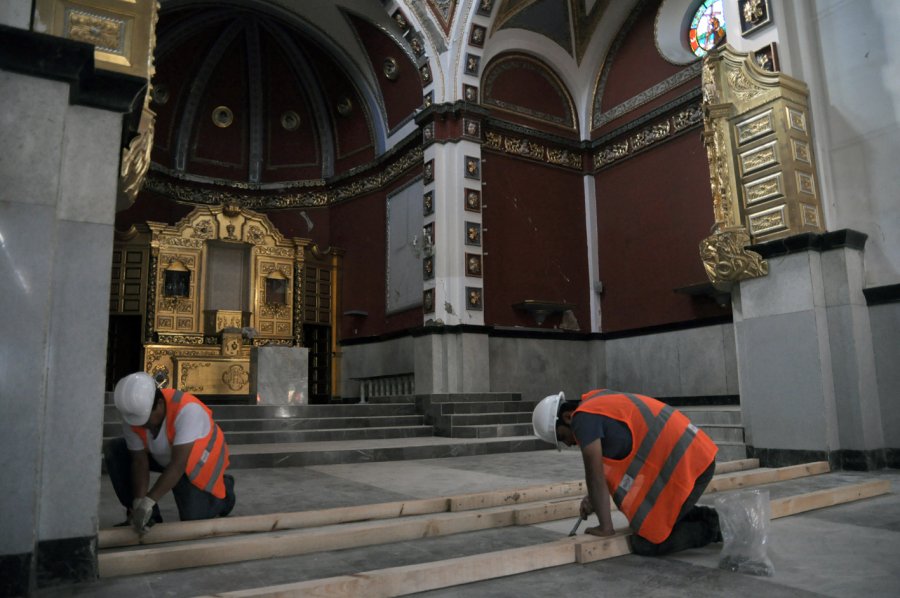Noticias
THE DEPARTMENT OF CULTURE REPORTS THAT 250 HISTORICAL MONUMENTS AND ARCHAEOLOGICAL SITES HAVE BEEN RESTORED TO DATE
April 02, 2018During the earthquakes of last September, eleven states were affected. The Department of Culture, together with specialists from the National Institute of Anthropology and History, the National Institute of Fine Arts and the General Directorate of Cultural Heritage Sites and Monuments, activated the protocols to deal with the emergency and initiate the corresponding actions, with the support of the affected communities.
At the end of the first quarter of 2018, the Department of Culture of the Government of the Republic reports that 253 cultural properties have been fully restored. 194 are historic buildings, 9 archaeological sites and 50 movable properties of historical value.
The states with the largest number of restored properties are Morelos with 32, Estado de México with 30, Puebla with 29 and Tlaxcala with 27.
The recovery of our heritage, due to the care it requires and the tasks of specialization, which are both scientific and artisanal, will take more than 30 months.
Among the restored buildings are the Chapel of San Francisco de Asís, in Cuernavaca; the Chapel of San Lorenzo, in Tlayacapan; the chapels of San Sebastián and Santa Cruz, in Tepoztlán; the Archaeological Museum of Xochicalco, the archaeological sites of Chalcatzingo and Coatetelco, in the state of Morelos.
In the State of Mexico, the Convent of the Holy Desert, in Tenancingo; the Sanctuary Señor del Sacromonte, in Amecameca; and the Temple of the Holy Cross, in Coatepec Harinas, stand out.
In the state of Puebla, the Chapel San Antonio in San Andrés Calpan; the Sanctuary of Nuestra Señora de los Remedios in San Andrés Cholula; and the Temple of the Holy Spirit "La compañía de Jesús" in the city of Puebla stand out. In the state of Oaxaca, we can highlight the Temple of San Jerónimo Doctor, in San Jerónimo Nuchita; the Temple of Santiago Apostol, in Santiago Patlanalá; and the Ex Convent of Santo Domingo de Guzmán, in the Oaxacan capital.
In the state of Chiapas, the Temple of Santa Cruz in Cunduacán and La Pila in Chiapa de Corzo stand out, as well as the parish of San Sebastián in Zinacantán. In Mexico City, the Chapel San Antonio Panzacola, the National Expiatory Temple of Felipe de Jesús and the Church Nuestra Señora de El Pilar"La Enseñanza" stand out. In the state of Tlaxcala, the archaeological sites of Acozac and Tlacopaya stand out, as well as the Parish Santa Inés in Zacatelco.
In the first stage of the Master Plan, which was completed in the first quarter of 2018, resources were made available from FONDEN and from the insurance available to INAH to cover damage to historical and archaeological heritage.
International support has been provided by the European Union and UNESCO, as well as solidarity from various countries such as Germany, Hungary, Spain, Italy and France. It is important to highlight the valuable contributions of private sector foundations and academic and religious institutions, such as the Harp Helú Foundation, the Carlos Slim Foundation, the Jenkins Foundation, the National Autonomous University of Mexico, the Federation of Colleges of Architects and the Mexican Episcopal Conference.
We are part of a Citizens' Committee with the participation of members of academic institutions, specialists and representatives of civil society, which guarantees the follow-up and continuity of the recovery of Mexican heritage.
The universe affected by the earthquakes of September 7 and 19, plus the one that occurred in 2018, has increased to more than 2,000 sites. With regard to the insurance policy of the INAH, to date, 853 reconciliations of real estate and 358 of movable property have been carried out. For its part, FONDEN authorized resources in the amount of $5,891 billion pesos.
We recognize the valuable contribution of the Departments of Tourism, National Defense, Navy, Finance and Public Credit, and Government, particularly the National Coordination of Civil Protection. Also, to state and municipal governments.
We continue to work intensely with the commitment to recover the historical and cultural heritage, which belongs to all Mexicans.
Mexico,Distrito Federal
